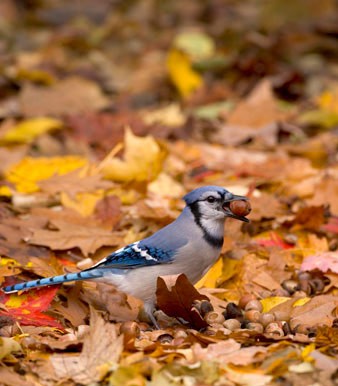I own 110 acres of northern hardwoods in a valley west of Mount Mansfield in northern Vermont. There are no oaks in my area, so when I built my home in 1978, I planted six red oaks around the house. They prospered and grew while I gradually cleared 30 acres to raise sheep. In the year 2000, the oak trees began dropping acorns. Several years later, I began finding oak seedlings along the forest edge, roughly 300-400 feet from the oaks I’d planted. I assumed squirrels had done the work. Then I read a book called Oak, the Frame of Civilization, by William Bryant Logan, which traces the origin of the oak from 65 million years ago and describes its importance to human civilization and wildlife in general.
The bluejay has been intimately connected with the oak for thousands of years. Equipped with powerful mandibles adapted for tearing the acorn husks and an expandable esophageal chamber capable of carrying four whole acorns at a time, the jay can transport acorns as far as a mile, usually to a place on the forest edge close to where they have their nests. In contrast, squirrels only carry acorns up to 100 feet from their source. Jays bury the acorns individually for food during the winter months. It is estimated that a jay may bury as many as 4,500 acorns each year. As few as one in four acorns are retrieved for food.
The jay’s activity explains why oaks have a dispersal rate of 1 to 2 miles per year. This powerful multiplying force helps to offset the many challenges to starting an oak forest, including seed predation by everything from weevils to deer.
To assist the process, I tag the young oaks I find with colored tape to identify and avoid injuring them. I transplant those located in less favorable sites to pots and care for them close to the house for a year or so. It’s important to transplant them when they are just sprouting to avoid injuring the vigorous taproot when digging them up. After a year or so, when I think they are strong enough, I transplant them to forest edges that I created with the sheep pastures. I use cedar posts and fencing to protect these young oaks from sheep and deer browsing until they are tall and strong enough to be on their own.


